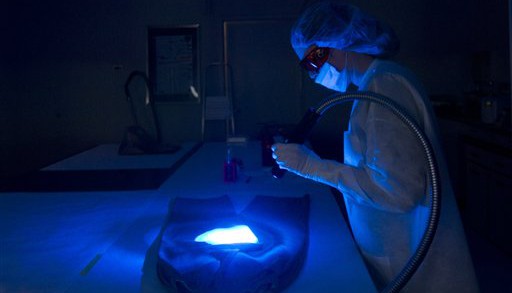

In this Friday, March 2, 2012 photo, Kimberly Stoddard, a forensic scientist at the New York State Police Forensic Investigation Center in Albany, N.Y., scans a garment for biological evidence. (AP Photo/Mike Groll)
New York is again debating expanding its DNA database, this time to include samples from every person convicted of a crime. The debate pits what backers say is solid science and more solved cases against critics who raise the possibility of tainted evidence and a secret stash of information that favors prosecutors.
The scientist running New York’s DNA crime laboratory said he cannot recall a single instance in 16 years when the lab produced bad genetic information that linked an innocent person to a crime. Instead, the work has helped police identify suspects in 12,000 cases, many of them previously unsolved, and exonerate 27 people wrongfully convicted.
“Every step in the process is associated with scientific controls to assure the accuracy of the results,” said Barry Duceman, a former Yale genetics researcher who was hired two decades ago to launch the state program. The lab repeatedly meets accreditation standards that require strict quality controls, he said.
Critics point to the potential for contaminated crime scene evidence and some processing errors in other states. They say the databank should at least be open to defense lawyers and at best be open to individuals who want to know if their DNA profiles are kept by police.
“The problem, in my judgment, is that the library is secret,” said Edward Blake, a genetic researcher who has produced DNA evidence that overturned several convictions. “That secrecy of the contents of that library is contrary to the principles of a democratic society.”
The Republican-controlled New York Senate recently approved and Democratic Gov. Andrew Cuomo is advocating the so-called clean bill to expand collections to lesser crimes, citing experience that shows many small-timers move on to robberies, rapes and murders that could be solved or prevented.
Since the addition of petit larceny to the databank more than five years ago, DNA collected from this minor crime produced leads in cases involving nearly 1,000 other crimes, including 53 murders.
Pending legislation repeatedly passed by the Democrat-run Assembly would expand DNA collection while increasing database access. That bill also includes mandates to prevent coerced confessions and witness errors by requiring videotaped police interrogations and a system of looking at photo arrays where neither the officer nor the witness knows if the suspect is included, a technique known as double-blind.
Last year, both bills died with no negotiated compromise.
Cuomo said last week he will consider changes to the clean bill, but only if they are strictly DNA-related, telling supportive prosecutors and police he is optimistic about getting that measure passed this year. He said he doesn’t want the bill freighted with the other criminal justice issues.
“They’re making a legitimate discussion for how we conduct investigations, how we do confessions, how we do line-ups. There are a lot of issues that we can discuss,” he said. “This is about DNA.”
All states take DNA from most felons and most also get samples from people convicted of misdemeanor sex crimes. California is the only state that requires DNA from all offenders, with samples taken when suspects are booked that can be later eliminated on request if the person is exonerated.
New York’s database has been expanded four times since it was established in 1996. The state collects DNA from all convicted felons and anyone convicted of one of 36 criminal misdemeanors. Both bills would add all penal misdemeanors and non-penal felonies, such as DWI and securities fraud.
The state’s database has the genetic profiles of about 416,000 offenders and more than 39,000 DNA markers from crime scenes. It is blind, without markers for race or names. In addition, it is linked to the FBI’s national databank that has more than 10 million genetic patterns from offenders and more than 400,000 from crime scenes.
When there’s a possible match, New York officials say, they get a fresh sample from the suspect to verify the finding.
“We’re real rock solid on who’s coming in,” State Police Deputy Counsel Stephen Hogan said.
Lawyer Barry Scheck, co-director of the Innocence Project who gained national prominence challenging DNA evidence in O.J. Simpson’s 1995 acquittal on murder charges, said sometimes defense attorneys want to process crime scene samples that authorities choose not to or retest samples authorities have already processed. He said even the best labs make mistakes.
But to get access to the samples under New York law, the defense has to apply to a judge and show “good cause.” And some judges don’t feel they have authority to grant access, especially when prosecutors oppose it, Scheck said.
Scheck said any expansion of New York’s database should come with better access for defendants. He said changing the way eyewitness identification is handled and videotaping interrogations in serious felony cases would do even more to catch criminals and protect innocent people.
Blake, the genetic researcher, also noted that prominent errors have occurred, including a Las Vegas case in which a man was imprisoned four years for robbery and kidnapping before police admitted that DNA evidence had been mishandled. An investigation showed samples were switched by a lab technician after the 2001 crime. Last year, the man won a $1.5 million settlement.
New York lab officials say their routine work has been instrumental in exonerating 27 people convicted of crimes and numerous others accused of crimes they didn’t commit. For instance, suspects in a double murder in Troy were cleared of charges after DNA data from an unrelated assault eight years after the killings implicated Michael Mosley. Mosley was convicted.
State officials say the DNA bill should be considered on its own. They have concerns about the effect of granting wider access to a closed-circuit system with its rigorous quality controls, expense, and the tendencies of some inmates to file multiple requests for reconsideration or, in this instance, for tests after their victims or the victims’ families thought the cases were over.
New York Chief Judge Jonathan Lippman said he wants the DNA database expanded but also wants better defense access, including a chance for defendants who have pleaded guilty to serious felonies to use the data to try to prove their innocence. Lippman said experience has shown some wrongful convictions even with guilty pleas.
Richard Aborn of the Citizens Crime Commission of New York City, an advocacy group for public safety, said he supports expanding the databank and believes concerns about its use are unwarranted. Wider defense access to the information could be addressed in another bill, he added.
“No one is interested in convicting the wrong person,” he said. “There must be some kind of way, with some sort of judicial proceeding, that we can make sure that those who should have access to DNA samples get access.”
Copyright 2012 The Associated Press.



